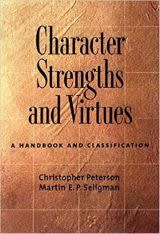Character Strengths and Virtues: A Handbook and Classification
The groundbreaking book, Character Strengths and Virtues, championed by Christopher Peterson and Martin Seligman, describes the VIA Classification of character strengths and virtues. The book outlines the results of a 3-year project led by Peterson and Seligman involving 55 distinguished social scientists. From Aristotle and Plato to the major world religions, to other great thinkers and philosophers spanning the last 2,500 years, this work represents the most significant effort in history to review, assemble, research, and classify positive strengths/traits in human beings. The result is a “common language” (scientifically speaking, a “consensual nomenclature”) for understanding and discussing these core capacities in human beings.
Character Strengths and Virtues is regarded as the backbone of the science of positive psychology and remains one of the most substantive efforts generated by the field. In turn, it draws interest from a wide range of professions and disciplines – education, management, consulting, psychology, coaching, and many others.
Character Strengths and Virtues is descriptive, not prescriptive. The emphasis is on classifying psychological ingredients of goodness in human beings across cultures, nations, and beliefs, rather than prescribing what humans “should” do to be good or improve themselves. Whereas the Periodic Table of Elements is a classification of elements on a microscopic level, the VIA Classification is a classification of positive traits in people. Strengths such as curiosity, kindness, bravery, perseverance, hope, gratitude, teamwork, humility, and fairness are part of this framework.
Each of these 24 character strengths is thoroughly reviewed in terms of what is known. These areas include:
- Paragon in history exemplifying the strength
- Consensual definition, based on the research literature
- Theoretical traditions
- Assessment measures
- Correlates and consequences of the strength
- Development of the strength
- Enabling and inhibiting factors
- Cross-cultural aspects of the strength
- Deliberate interventions involving the strength
- Whether or not the strength meets each of 10 character strengths criteria – how, why, why not.
- What is not known about the strength
- Articles, books, and references for the strength
The VIA Classification is not a taxonomy of strengths as taxonomies require an underlying deep theory explaining multiple relationships between constructs. Instead, it is a “classification,” a conceptual scheme that is holistic. The framework offers cognitive strengths (under the virtue of wisdom), emotional strengths (courage), social & community strengths (humanity & justice), protective strengths (temperance), and spiritual strengths (transcendence).
The reference for the book is: Peterson, C., & Seligman, M. E. P. (2004). Character strengths and virtues: A handbook and classification. New York: Oxford University Press and Washington, DC: American Psychological Association.
Affiliate disclosure: As an Amazon Associate, we may earn commission from qualifying purchases from Amazon.com
